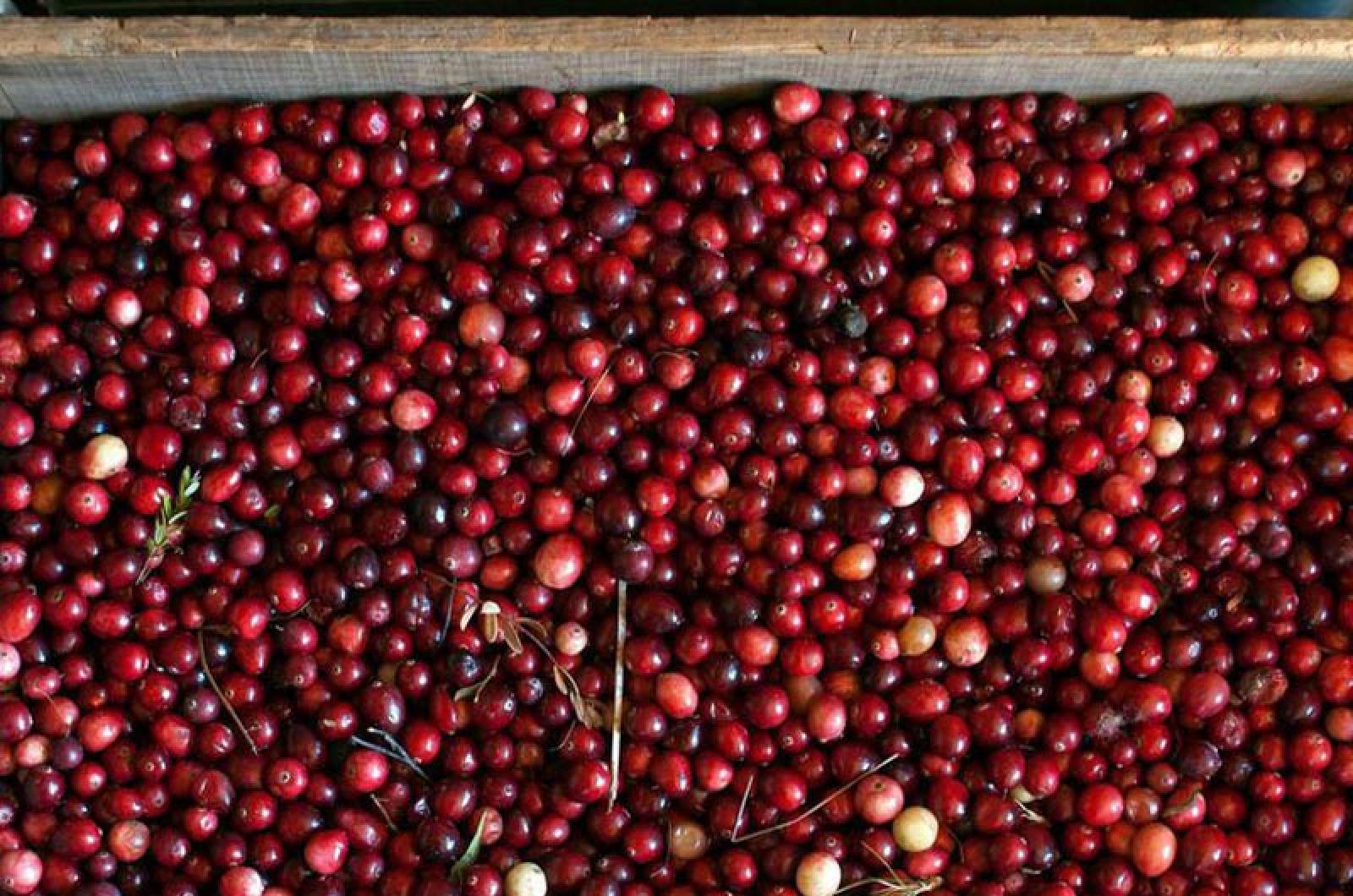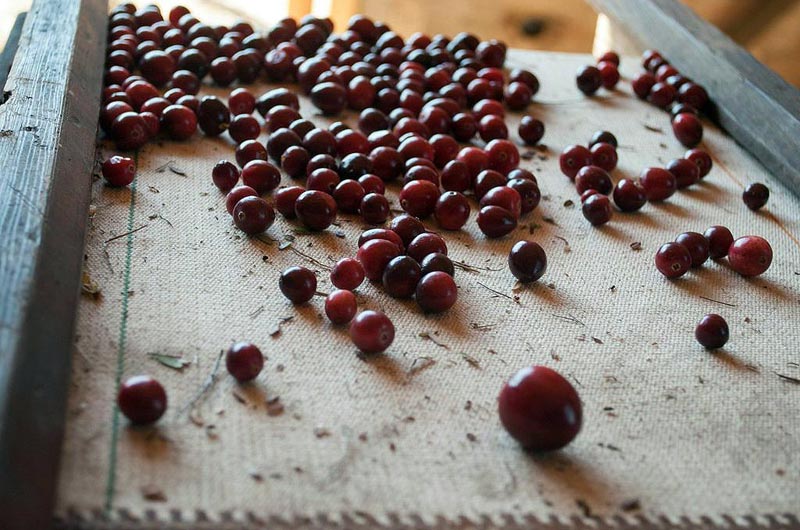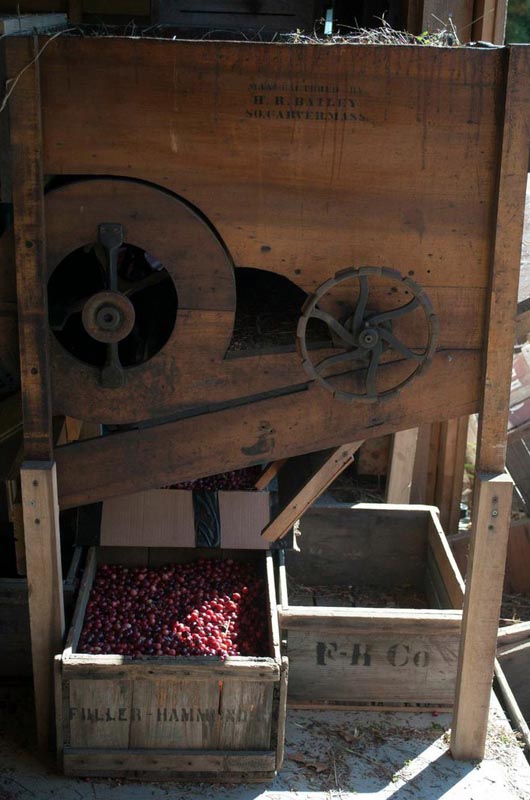On Halloween morning, Carol Magee, the executive director of the Vineyard Open Land Foundation, gave me my first lesson in cranberry sorting. We stood in the newly renovated barn beside VOLF’s cranberry bog on Lambert’s Cove Road, and Carol rolled a cluster of cranberries gently under her hand.
“We’re looking for richly colored, perfectly round cranberries,” she said. “When you roll them like this, the light catches any dings on the berry. Berries with dings go in this box, ones that are too white go in that box, and squishy, rotten ones go in the box at the end,” she explained, pointing at three wooden crates at our feet. “We only put the perfect ones in this box, which I check again myself before we weigh, package, and sell them.” Carol was not kidding around about quality control.
Laid out before us on a conveyer belt was a single layer of beautiful red cranberries that had been harvested earlier in the month from VOLF’s bog. The conservation organization has spent the last 10 years carefully restoring this bog, replanting vines, and harvesting and maintaining the site using only traditional methods and equipment.
The VOLF bog is the only commercial bog left on Martha’s Vineyard, and is unique not only on our Island but stands out in the cranberry industry overall. For one thing, the bog is certified organic, and has been since 2000. Only about one per cent of all cranberries grown in the U.S. and Canada are grown organically. VOLF also dry-harvests their berries so that they can be used as fresh fruit, rather than flooding the bog at harvest time to separate berries from the vines. Dry-harvesting, the traditional method of cranberry harvesting, is much more labor-intensive than wet harvesting, and is only done on about five per cent of the total cranberry crop. Wet-harvested berries are dried or processed for juice, sauce, or powder.
Perhaps most unique of all is VOLF’s success in selling their crop and fetching a high price for their harvest. Their berries sell for $10 per pound, and after seeing the incredibly detailed work that goes into sorting the berries — not to mention the careful, respectful way the bog is tended and harvested — this seems like an absolute steal. The funds VOLF raises from selling the cranberries also goes back into bog restoration and education efforts.
Meanwhile, cranberry growers elsewhere in Massachusetts, and across the country, are struggling to sell their harvest at a tiny fraction of this price. The average cost of producing conventionally-grown, wet-harvested cranberries in Massachusetts is roughly 39 cents per pound, but they are now selling at an average of only 32 cents per pound, and for as low as 15 cents per pound.
Growers are facing a classic over-supply problem. Between 2002 and 2013, U.S. production of cranberries went up 57 per cent. Canada went from producing almost no commercial cranberries in 1996 to three million barrels a year by 2012. Industry leaders were hopeful that new markets would open for cranberry products at home and abroad, but demand has not kept pace with the staggering increase in supply. As a result, the vast majority of last year’s cranberry crop grown in Massachusetts is being held in storage, even as a bountiful new crop is now being harvested. Many cranberry growers in our state, whose families have been growing cranberries in natural bogs for generations, are not sure that they can afford to keep growing in the years to come.
While most commercial growers struggle, the VOLF bog is thriving, as cranberries have done on this Island for thousands of years. Cranberries have played an important role in Wampanoag culture for many, many generations. They have been and continue to be used by tribal members as a staple food, a fabric dye, and a healing agent. Cranberry Day remains one of the Wampanoag tribe’s most important holidays, bringing all ages together to harvest some of the cranberries that grow wild on 200 acres of tribal land on the Vineyard, and to tell stories, sing songs, and feast together to celebrate the cranberry and all it gives.
In October, Island Grown Schools chose the cranberry as our harvest of the month crop. We served taste tests of our featured cranberry relish recipe to over 2,000 Island students, teachers and school staff, and led many field trips to the VOLF bog. The students loved seeing the beautiful old wooden machines that the VOLF team uses to harvest, winnow and sort the berries, and got to practice sorting, as Carol taught me to do.
“In the past, we’ve harvested about 300 pounds a year,” she explained. “This year, we’re looking at a 1,000-pound harvest, now that the bog is more established and that we’ve found better ways of keeping deer out.” With growing demand from Island restaurants, caterers, school cafeterias and home cooks, she is hopeful that this year’s crop will sell out. “The whole buy-local movement on the Vineyard is really supporting this restoration effort — three years ago people weren’t buying like they are now,” she said.
While the cranberry industry focuses energy on trying to develop new markets in China and other countries that have not traditionally eaten cranberries, it may be up to local communities to support their local cranberry growers if the long tradition of cranberry production in Massachusetts is to persist. You can be part of protecting this heritage on the Vineyard by visiting and supporting the bog at VOLF, reading Jeanette Vanderhoop’s wonderful children’s book Cranberry Day, and by purchasing Massachusetts-grown whenever you buy cranberries.









Comments (7)
Comments
Comment policy »